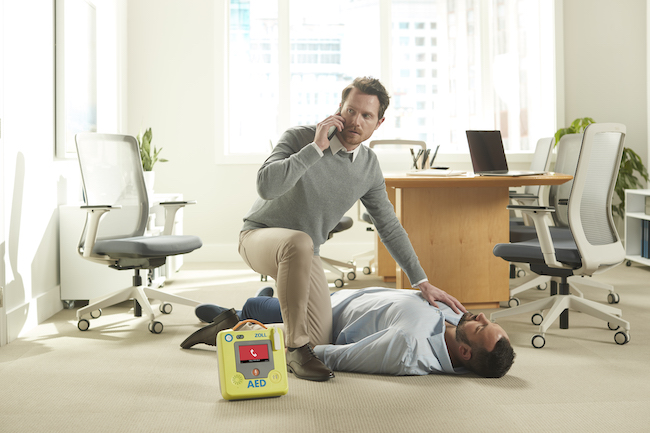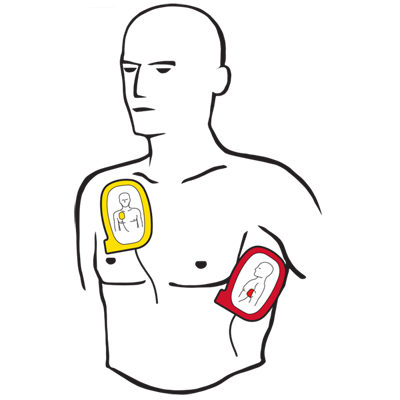Roughly 356,000 people suffer from out-of-hospital sudden cardiac arrest (SCA) each year in the United States. SCA is caused by an electrical malfunction of the heart which leads to an improper heartbeat. In many instances, an automated external defibrillator (AED) will be needed to send an electric pulse to the heart to restore normal rhythm. In this guide, we’ll walk through every step of how to use an AED to help ensure you’re prepared in the event of an emergency.
AED Steps
Learning how to use a defibrillator to treat someone can sound intimidating. However, the more you familiarize yourself with the AED steps, the more comfortable you’ll be to jump into action and save a loved one, coworker, or stranger suffering from SCA. AEDs are designed to guide rescuers through an emergency and will tell you what to do next with audio and visual cues, so be sure to follow the AED instructions as they’re given. Now, let’s discuss the simple steps to using an AED.
Step 1: Call 911 and Locate an AED
If you suspect someone is suffering from SCA, immediately call 911 and send someone to find the closest AED. Follow the instructions given by the dispatcher. Calling 911 and fetching an AED are tasks that should be delegated to other bystanders if possible, so you can focus on helping the victim. To be clear, CPR coupled with a shock by an AED is the only way to save someone who is experiencing an SCA.
 Step 2: Check the Victim and Begin CPR
Step 2: Check the Victim and Begin CPR
Check your surroundings to ensure the scene is safe, tap and shout at the victim to see if they are unconscious, check if they are breathing, and feel for a pulse. If there is no pulse, begin hands-only CPR. To deliver the most effective CPR, perform compressions at a pace of 100 to 120 per minute with a minimum depth of two inches. Visit the Mayo Clinic to learn more.
Step 3: Turn on the AED and Attach the Pads
Once you turn on the AED you should begin following the machine’s audio and visual prompts. Attach the AED pads to the patient and plug in the connector (if necessary). The first pad goes under the patient’s right collarbone, above the pectoral muscle, known informally as the pec. The second pad goes on the left chest, under the armpit. To learn more about pad placement, refer to our pad placement guide.
Step 4: Deliver a Shock (If Needed)
Once the pads are connected, make sure you are no longer touching the patient. The AED will analyze their heart rhythm by searching for electrical signals, so it’s important to ensure there is no interference. Depending on your AED model, this process will happen automatically or following a prompt and button press. If a shock is needed, the AED will either administer automatically or will advise you to press a button to do so.
For infants and children, most AEDs can deliver a lower shock level. How this is done depends on the model you have. Some machines have special pediatric pads, while others rely on an infant/child key or toggle switch.
Step 5: Continue CPR
After the AED delivers a shock or if no shock is advised, resume CPR and continue to follow the AED’s prompts. If the patient regains consciousness or shows other clear signs of life, stop CPR until paramedics arrive and continue to monitor vitals.
Closing Thoughts
Now that you know how to use an AED and how important they are, we hope you join us in our mission of placing more AEDs in communities and spreading awareness of what to do in the event of a cardiac arrest. If you have any questions, reach out to our customer service team and we’ll be happy to help. If you want additional training, check out our resource on AED classes near you.
Sources
- Sudden Cardiac Arrest Foundation. “SCA Stats.” https://www.sca-aware.org/. 16 September 2021.
- Mayo Clinic. “Cardiopulmonary resuscitation (CPR): First aid.” https://www.mayoclinic.org/. 16 September 2021.
 Written by Blaire Czarniecki
Written by Blaire CzarnieckiCustomer Service Director
Blaire attended the University of Tennessee where she graduated with a Bachelor of Science in Human Ecology- Child and Family Studies. She has been in the Automated External Defibrillator (AED) industry for over eight years and is the Director of Customer Service for Coro Medical. Blaire is also an American Red Cross-certified CPR/AED/First Aid Instructor, highly trained by each manufacturer on their specific AEDs, and knowledgeable regarding ALL State AED regulations and legislation.“I know that every day I come to work, I am playing a part in saving someone’s life. I am passionate about these devices and am always looking for new and innovative ways to spread awareness and knowledge about Sudden Cardiac Arrest (SCA). I look forward to the day when everywhere I go, I will see an AED—when SCA will no longer take any lives.”
Last updated October 27, 2021.






